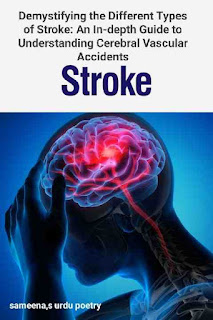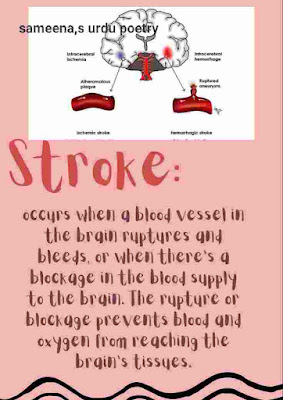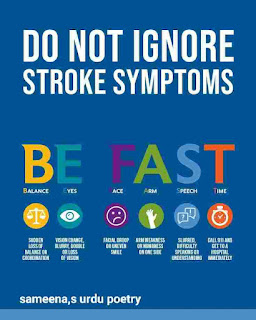Demystifying the Different Types of Stroke⚠️⚠️
hello and welcome to our website to day our topic is types of stroke we are giving you full information about that so please read full details here
Stroke is a serious medical condition that affects millions of people worldwide. It occurs when blood flow to the brain is disrupted, leading to potential brain damage and a wide range of long-term disabilities. Understanding
the different types of stroke is essential for early detection and appropriate treatment. In this comprehensive guide, we delve into the world of cerebral vascular accidents to demystify the intricacies of these life-altering events. Whether you've heard terms like ischemic stroke, hemorrhagic stroke, or transient ischemic attack (TIA), we're here to break them down and provide a clear understanding of each type. By exploring the causes, symptoms, risk factors, and diagnostic methods associated with each stroke variation, we'll equip you with the knowledge to recognize warning signs and seek timely medical intervention. Throughout this guide, we'll debunk common misconceptions about strokes, dispel myths, and provide accurate information based on the latest scientific research. By demystifying the different types of strokes, we hope to empower you to make informed decisions about your health and the health of your loved ones. Join us on this enlightening journey as we unravel the complexities of strokes and strive to save lives through knowledge and awareness
.
Stroke is a serious medical condition that affects millions of people worldwide. It occurs when blood flow to the brain is disrupted, leading to potential brain damage and a wide range of long-term disabilities. Understanding the different types of stroke is essential for early detection and appropriate treatment. In this comprehensive guide, we delve into the world of cerebral vascular accidents to demystify the intricacies of these life-altering events.
Whether you've heard terms like ischemic stroke, hemorrhagic stroke, or transient ischemic attack (TIA), we're here to break them down and provide a clear understanding of each type. By exploring the causes, symptoms, risk factors, and diagnostic methods associated with each stroke variation, we'll equip you with the knowledge to recognize warning signs and seek timely medical intervention.
Throughout this guide, we'll debunk common misconceptions about strokes, dispel myths, and provide accurate information based on the latest scientific research. By demystifying the different types of strokes, we hope to empower you to make informed decisions about your health and the health of your loved ones.
Join us on this enlightening journey as we unravel the complexities of strokes and strive to save lives through knowledge and awareness.
Ischemic strokes: causes, symptoms, and treatment options
Ischemic strokes are the most common type of stroke, accounting for around 80% of all cases. They occur when a blood clot or plaque blocks an artery leading to the brain, cutting off the blood supply. This interruption in blood flow results in a lack of oxygen and nutrients, leading to brain cell damage or death.
There are two main types of ischemic stroke: thrombotic and embolic. Thrombotic strokes occur when a blood clot forms in one of the arteries supplying blood to the brain. This clot usually develops in an area where the blood vessel is already narrowed due to plaque buildup. On the other hand, embolic strokes occur when a blood clot or other debris forms elsewhere in the body and travels to the brain, blocking a blood vessel.
Symptoms of ischemic strokes may vary depending on the area of the brain affected but often include sudden weakness or numbness on one side of the body, difficulty speaking or understanding speech, vision problems, and severe headaches. Treatment options for ischemic strokes include medication to dissolve blood clots, surgical procedures to remove blockages, and rehabilitation therapies to regain lost functions
.
Hemorrhagic strokes: causes, symptoms, and treatment options
Unlike ischemic strokes, hemorrhagic strokes are caused by bleeding in the brain. This bleeding can occur due to a ruptured blood vessel or an aneurysm. Hemorrhagic strokes are less common but often more severe than ischemic strokes, leading to a higher risk of disability or death.
There are two main types of hemorrhagic stroke: intracerebral and subarachnoid. Intracerebral hemorrhages occur when a blood vessel ruptures within the brain, causing bleeding and subsequent damage to the surrounding tissue. Subarachnoid hemorrhages, on the other hand, occur when a blood vessel on the brain's surface ruptures, leading to bleeding in the area between the brain and the skull.
Symptoms of hemorrhagic strokes may include sudden and severe headaches, nausea or vomiting, seizures, weakness or numbness on one side of the body, and loss of consciousness. Treatment options for hemorrhagic strokes focus on stopping the bleeding, relieving pressure on the brain, and preventing complications. These may include medication to control blood pressure, surgical interventions to repair blood vessel abnormalities, and rehabilitation therapies for recovery.
Transient Ischemic Attacks (TIAs): mini-strokes and their significance
Transient Ischemic Attacks (TIAs), often referred to as mini-strokes, are temporary disruptions of blood flow to the brain. Although they resolve relatively quickly, TIAs should never be ignored, as they are warning signs of an impending stroke. TIAs occur when there is a temporary blockage in the blood vessels supplying the brain, leading to temporary symptoms similar to those of a stroke.
The symptoms of a TIA may last only a few minutes to a few hours and can include sudden weakness or numbness on one side of the body, difficulty speaking or understanding speech, and temporary vision loss. It is crucial to seek immediate medical attention if you experience any of these symptoms, as TIAs can serve as a warning sign for a more severe stroke in the future.
Risk factors for strokes and how to prevent them
Certain risk factors increase the likelihood of experiencing a stroke. These risk factors can be categorized into two main types: modifiable and non-modifiable. Non-modifiable risk factors include age, gender, ethnicity, and family history of strokes. While we cannot change these factors, being aware of them can help identify potential risks.
Modifiable risk factors, on the other hand, can be addressed and managed to reduce the chance of having a stroke. These include high blood pressure, high cholesterol levels, smoking, obesity, diabetes, and a sedentary lifestyle. By adopting a healthy lifestyle that includes regular exercise, a balanced diet, quitting smoking, and controlling chronic conditions, we can significantly reduce the risk of stroke.
Recognizing the signs and symptoms of a stroke
Recognizing the signs and symptoms of a stroke is crucial for timely intervention and treatment. Remembering the acronym FAST can help you identify the warning signs:
- Face drooping: One side of the face may droop or feel numb. Ask the person to smile and check if their smile is uneven.
- Arm weakness: One arm may become weak or numb. Ask the person to raise both arms and see if one arm drifts downward.
- Speech difficulties: Speech may be slurred or difficult to understand. Ask the person to repeat a simple phrase and check for any speech abnormalities.
- Time to call emergency services: If you observe any of these symptoms, it's time to call for emergency medical assistance.
Acting quickly is crucial, as every minute counts when it comes to stroke treatment. The sooner medical intervention is sought, the better the chances of minimizing brain damage and achieving a successful recovery.
Diagnosing strokes: medical tests and imaging techniques
Diagnosing a stroke involves a combination of medical tests and imaging techniques. These help determine the type of stroke, its cause, and the extent of brain damage. Common diagnostic methods include a physical examination, blood tests, imaging scans such as CT scans, MRI scans, and angiograms, and electrocardiograms (ECGs).
During a physical examination, doctors assess vital signs, evaluate neurological symptoms, and check for any physical abnormalities. Blood tests can help identify underlying conditions that may contribute to strokes, such as high cholesterol levels or blood clotting disorders. Imaging scans provide detailed pictures of the brain, allowing doctors to identify the location and extent of brain damage.
Rehabilitation and recovery after a stroke
Recovery after a stroke is a complex and individualized process. Rehabilitation plays a crucial role in helping survivors regain lost functions, relearn skills, and adapt to any disabilities caused by the stroke. Rehabilitation programs may include physical therapy, occupational therapy, speech and language therapy, and psychological support.
Physical therapy focuses on improving strength, balance, and mobility. Occupational therapy helps individuals regain the ability to perform daily activities such as dressing, eating, and bathing. Speech and language therapy aid in recovering communication skills and swallowing abilities. Psychological support and counseling are essential for addressing emotional and mental health challenges associated with stroke recovery.
Support and resources for stroke survivors and their caregivers
Stroke survivors and their caregivers often require ongoing support and resources to navigate the challenges of life after a stroke. Various organizations and support groups provide valuable assistance, information, and emotional support. These resources can help survivors and their caregivers connect with others who have had similar experiences, share coping strategies, and access helpful tools and information.
Additionally, healthcare professionals, including doctors, nurses, and therapists, play a vital role in supporting stroke survivors and their caregivers throughout the recovery journey. They provide guidance, answer questions, monitor progress, and offer recommendations for further assistance.
Conclusion: raising awareness and promoting stroke prevention
In conclusion, understanding the different types of stroke is crucial for early detection, appropriate treatment, and improved outcomes. By demystifying strokes and raising awareness about the causes, symptoms, and treatment options, we aim to empower individuals to recognize warning signs and seek timely medical intervention.
Prevention plays a significant role in reducing the burden of strokes.
By managing modifiable risk factors, recognizing warning signs, and adopting a healthy lifestyle, we can significantly reduce the incidence of strokes and improve overall quality of life. Let us strive to spread knowledge, raise awareness, and work towards a future where strokes are preventable and lives are saved.
Remember, knowledge is power, and together, we can make a difference in the fight against strokes
We are giving you yoga meditation ebook here
Just click this link and download







.png)



0 Comments
Plzz leave a comment and any suggestions